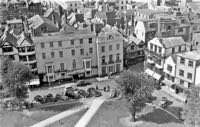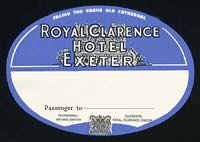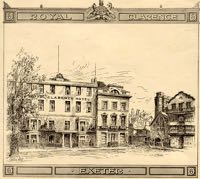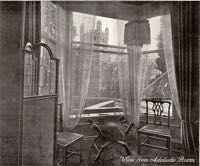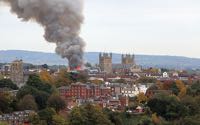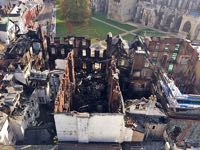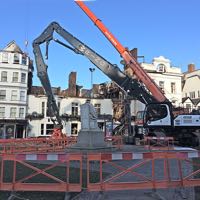
The Royal Clarence Hotel, Cathedral Close
Page updated 6th January 2024
 The Royal Clarence Hotel was
built by William Mackworth
Praed in 1769 as the
Assembly Rooms. Praed held leases on tenements near the Cathedral, and land in St David's, before he took a lease on the site in 1766.
The Royal Clarence Hotel was
built by William Mackworth
Praed in 1769 as the
Assembly Rooms. Praed held leases on tenements near the Cathedral, and land in St David's, before he took a lease on the site in 1766.
Before the Hotel
Limited archeological excavations in the basement of the hotel exposed a Roman occupation at the lowest level. By the 13th Century, the Cathedral was going through its Gothic rebuild, and it is believed that there was a Canon's house on the site. The layout consisted of a large hall, behind the frontage, with chambers on the front and the usual domestic rooms such as kitchen and brewhouse at the rear. There was a gateway, on the right, giving access to the rear from Cathedral Yard. The first two floors of the facade, and a side wall of the assembly room, probably dates from this period. The Well House and Exeter Bank belonged to the Vicar's Choral, while the Canon's House under the jurisdiction of the Dean and Chapter. From the early years of the 18th Century, the corner site on which the bank was constructed was the Rummer Inn.
Mackworth-Praed constructed his Assembly Rooms in a Georgian style–the entrance was on the left of the building, with a columned porch and pitched roof, and a similar coach entrance on the right. He added two extra floors, and the arrangement of the windows, with a large gap in the middle, suggest he may have planned to turn the building into two houses, if the hotel failed. See the 3D model on the right.
Assembly Rooms and Hôtel
The viability of the Assembly Rooms must have been in question, for on the 7 September 1770, an advert was placed by Pierre Berlon, the French proprietor using the word hôtel for the first time in England.
In July 1776, the former proprietor of the Swan Inn situated in the High Street, Richard Lloyd announced in the Old Exeter Journal that he had "now taken the HOTEL, in St Peter's Church-Yard, which is fitted up in the most elegant manner." The advert ends with "The CHAISES, COACHES, DILIGENCE, &c, will continue at the Hotel, as before." Although initially just called 'The Hotel', it became 'The Cadogen Hotel' for a short time. The manager of the 'The Cadogen Hotel' was an ex-waiter, Thomas Thompson, who renamed it 'Thompsons' for the next 20 years. It then became, 'Phillips Hotel'.
Jenkin's 1806 History of Exeter described the hotel thus:
"The only house, worthy of notice in its parish is, The Hotel, a large commodious Inn, with elegant apartments and Hotel accommodation for people of the first quality, with a large assembly room in which assize balls, concerts and assemblies of the most distinguished persons of City and Country take place, in the front is a neat coffee room. The situation of 'The Hotel' is very pleasant as it opens to the parade and commands a noble view of the Cathedral."
In June 1826, Sarah Street, who had kept the London Inn in Sidmouth, became the proprietor. It would appear from a cryptic line in an advert at the time, that some thought the new, female proprietor could not run the hotel without, probably, male backing. The advert stated:
"S S. embraces this opportunity of declaring to the Nobility, Gentry, and her friends in general, that she carries on the business of the Hotel perfectly independant of any other party whatever. A most malicious and unfounded report having been circulated on the subject, induces her to make this public declaration.—June 19, 1826."
Street refurbished The Hotel by adding the Egyptian Hall, which became a unique selling point in adverts for lectures and other events.
Famous Visitors
It was under Sarah Street that The Hotel was renamed. The Duchess of Clarence (Queen Adelaide), wife of the future William IV, stayed there in July 1827, and permission obtained to rename The Hotel, the Royal Clarence Hotel. An earlier newspaper report said she was to stay at the New London Inn, but the arrangement was changed, and reported thus:
"The arrangements at Streets Hotel was such as to afford her Royal Highness every comfort and accommodation; her Royal Highness had previously directed that a good and plain dinner should be provided, to which the Princess sat down about 10 o'clock... It is a singular coincidence as far as regards the city, that yesterday was the anniversary of her Royal Highness’s marriage with the Lord High Admiral."
A more recent Royal visitor to the Clarence was Lord Louis Mountbatten, on 14 August 1950. The next day he visited the Royal Naval Stores Depot on the Topsham Road, before proceeding to Plymouth.
Earlier, in 1801, Admiral Lord Nelson received the freedom of the city, after the Battle of the Nile. Nelson was waylaid passing through the city by an entourage led by the Mayor, taken to the Guildhall, where the honour was conveyed, and was presented with a sword. The intention was for Nelson to dine with the Mayor and other dignitaries at the Guildhall. However, Nelson insisted on returning to the Clarence, where he was staying, to address the gathered newspaper correspondents, before dining at the hotel.
In August 1840, Franz Liszt gave two piano recitals at the Clarence while touring England with a small group. He later wrote to his mistress that English cathedrals were not so crowded with shops and houses as those in France and therefore were more impressive. A blue plaque commemorating Listz's recitals was erected on the building, by the Exeter Civic Society in 2013.
Thomas Hardy stayed, along with his second wife at the Royal Clarence in 1915, while visiting a friend in Torquay.
It was during the Second World War, when the Americans were based in Exeter before D-Day, that both Clark Gable and Gary Cooper stayed at the Royal Clarence Hotel. They were already established Hollywood actors who were serving in the US air force.
The old Assembly Rooms were often used for concerts and dance bands. One such, for the Easter season, 1940, was Arthur Rosebery, described as "the famous pianist, song-writer, and dance-band leader... (he) has won the reputation of being one of the greatest showmen among dance-band leaders, so Exeter may look forward to some slick comedy, well to above-the-average music, during his visit." He had previously spent two and a half years as musical director at the Paradise Club in London.
Stage Coaches
During the age of the stage coach, Exeter's inns and hotels would compete for business by ensuring they were the terminus for prestigious services. The Royal Clarence was no exception, as it offered its clientele the Royal Bath and the London Mail services. Indeed, after a particularly frightening accident, in which a Clarence bound stage coach ran amok across the Close, after it clipped the narrow entrance of the Broadgate, the city authorities decided to demolish the old gate and ease the entrance.
It was in the Royal Clarence that during 1815, a meeting was held to plan the introduction of gas to light the streets of the city. Exeter was the first place in Devon to pioneer town gas, and the first gas lights were installed in the High Street. The building was extensively remodelled in the Egyptian style in 1827.
The Twentieth Century
In 1916, the Clarence opened the first cocktail bar, called the Zodiac Bar - during 1939, such exotic drinks as Tugboat Annie, the Corpse Reviver and Gloom Chaser were concocted to cheer up Exonians heading into the Second World War. Such bars were becoming popular at this time and it was the talent of Mr 'Ginger' Wood, who invented the Gloom Chaser, that made the bar a success with a range of 51 different cocktails. The bar was later named the Bishop Bar before closing in the 1980's.
Banking and pubs
The Royal Clarence was purchased by Andrew Brownsword and Michael Caines, the chef in 2000, to become the first Abode Hotel in their hotel group. Michael Caines left in early 2016 to pursue his interests elsewhere.
The Exeter Bank opened on 9th July 1769 on the site of the aforementioned Rummer Inn. It became the first Deller's Cafe in Exeter during 1906. Sometime after 1919, Deller's closed, having opened a new cafe in Bedford Street. The Clarence took over the premises, and had 27 rare 16th and 17th Century Flemish stained glass windows installed by Maurice Drake, who had his glass studio at No. 4 Cathedral Yard, one of the Three Gables.
On the opposite side, the Well House Tavern is also owned and run by the Abode Group. The original building was a Norman hall and was constructed on part of the medieval burial ground before tenements were built in the 15th century. The upper floors were added in the 17th century. Veitch's, the nursery and seed merchant used the premises as a shop until the 1980's when it briefly became an estate agent, a bookshop and then the Well House in 1984.
It is said that because the hotel occupies ecclesiastical land, only the verger of the Cathedral has the right to arrest drunks, as the police have no jurisdiction in the premises.
The royal crest on the front facade of the building originally dated from when the hotel gained royal patronage from the Duchess of Clarence. In 1989, it was decided that the crest be removed and refurbished. When the crest was lowered to the ground it was found to be in a very poor condition. The Vulcan Works in Water Lane gained the contract to make an exact copy out of fibreglass. It took three months before it was ready, and put back into place.
28 October 2016
Perhaps the biggest tragedy for the city, for its historic heritage since the blitz of 1942, was the fire in Cathedral Yard that destroyed the Royal Clarence. The fire was discovered at 5.30am in, 18, Cathedral Yard, the upper floors of which, were in the process of being converted into luxury apartments. Despite the best efforts of the Devon and Somerset Fire Service, with elements of the Dorset Fire Service, within hours the building was gutted. It was thought the worst was over, until flames started leaping through the roof void of the Well House to the Royal Clarence. The fire fighters struggled to prevent it spreading ever further. By early afternoon, not only smoke could be seen from across the city, but flames leapt high into the sky. The fire burned through the afternoon and night, as the Union Flag defied the inferno, eventually to succumb, and half the Royal Crest tumbled into the ruins. The fire was still burning on the morning of the 29 October, fed by a broken gas main–the grand old hotel was a sorry sight, completely gutted, while the front wall was collapsing. By lunch time, damping down was continuing, and structural engineers assessing the safety of the front facade.
At the time of writing, the people of the city are stunned. That one of the jewels of our city has gone, can't be argued with, but talk of restoring the Royal Clarence and 18, Cathedral Yard is on everyone's lips, and we can only look forward to, as they said about Exeter after the blitz, the Royal Clarence Hotel rising like a Phoenix from the flames.
On 8 November 2019, repairs were completed on 18 Cathedral Yard, having undergone a 3 year restoration which was undertaken by the same restorers who restored Windsor Castle following the fire in 1992. There was then a 2nd round of bids for the sale, and restoration work to complete the repairs of The Well House Tavern Pub and The Royal Clarence Hotel.
On 18 August 2020, the site was sold to James Brent of South West Lifestyle Brands Ltd, and the former chairman of Plymouth Argyle FC. The approved planning permission was already in place for reconstruction of the Royal Clarence Hotel façades as a 74-bedroom hotel due to be completed after 18 months. However, on 28 October 2021 the development company said the hotel scheme was "significantly unviable" and it was working on an alternative plan.
On 1 December 2021, proposals were announced by property developer Akkeron Group for a £17 million restoration and reconstruction of the original facade and exterior, with twenty-three luxury apartments, and the ground floor fully accessible to visitors as The Well House Pub, featuring a bar, a large restaurant and two function rooms. Akkeron chairman James Brent said the redevelopment plans would "breathe new life into the historic and much-loved Royal Clarence building... We are also focused on retaining as much of the building's historic fabric as possible, restoring the famous façade to its former glory, so the Royal Clarence will look much as it previously did before the fire."
The restoration planning permission was approved on 11 October 2022. Demolition and reconstruction works will need to be undertaken to the remaining fabric and to buildings around the site, including St Martin's Lane, which were said to be "unsalvageable" after being exposed to the elements for a number of years. It was agreed that plans be drawn up soon to "retain and showcase as many historical features of the remaining building fabric as possible"
Sources - Two Thousand Years in Exeter by W G Hoskins, Exeter Remembers the War by Todd Gray, Exeter Past by Hazel Harvey, and original memorabilia and adverts. The British Library Newspaper Archive. The Cathedral Archive. A talk by Richard Parker given after the fire.
This is a 3D model of the Royal Clarence as it would have been in 1769. The shape of all the buildings, and the front of the Clarence are based on solid evidence. Click and wait for it to load, then move the pointer over the model. You can zoom, pan and enlarge the model.

View of the north side of the Cathedral from Catherine Street, Martins Lane. The Rummer Inn is on the right. From Roques 1744 map of the city.
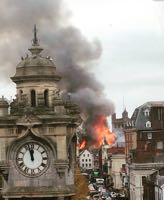
The Clocktower, Rougemont Hotel and Cathedral as flames leap up from the Royal Clarence Hotel, 28 October 2016. Photo by Brian Arnold.
│ Top of Page │


